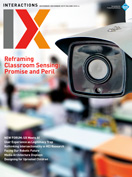Authors:
Paulina Yurman, Marloes Bhömer, Renee Noortman, Britta F. Schulte, Paul Marshall, Saskia Bakker, Anna Cox, Alexis Begnoche, Jurrian van Geest, Beth Grimmer, Thijmen Langendam, Nanda Schellingerhout, Martin Havranek, Aadjan van der Helm, Wouter van der Hoog, Tomasz Jaskiewicz, Jakob Lehr
 1. A Smartphone in the Nursery
1. A Smartphone in the Nursery
How can experiments in design explore the role of smartphones for mothers and young children? How can these designs be used to prompt conversations and explore potentials for change? This research used experimental and suggestive artifacts as conversational probes, inviting participants to interpret them and thus to tell of their own experiences using smartphones during childcare—practices that are often private and ridden with complexity. Informed by critical design, feminist, and psychoanalytic perspectives, the research engages with ambivalences toward the presence of smartphones in the world of mother and infant, portraying mothers as complex users of technology.
Yurman, P. A smartphone in the nursery. Proc. of the 4th Biennial Research Through Design Conference. 2019; https://figshare.com/articles/A_smartphone_in_the_nursery/7855757
Yurman, P. Designing for ambivalence: Mothers, transitional objects and smartphones. Proc. of the 2017 CHI Conference on Human Factors in Computing Systems. ACM, New York, 2017.
Paulina Yurman, Goldsmiths, University of London
 |
Uncanny Pet uses the metaphor of a sleeping pet to invite mother and child to take a break from the phone. It snores. |
 |
Herby is a phone on wheels that gets irritated when used as a toy, protesting "I am not a toy" or "Take me to your mum." |
 2. A Measurable Factor Sets the Conditions of Its Operation
2. A Measurable Factor Sets the Conditions of Its Operation
This is an ongoing research project and series of publicly exhibited materials originally developed through the Stanley Picker Research Fellowship at Kingston University. The project aims to rethink the ways in which shoes are designed by shirking traditional approaches. Instead, it employs an engineering method based on structural parameters, informed by biomechanical factors, required to support a high-heeled foot while in motion. In this project, the shoe is approached as a constellation of interlinking areas of support, producing genuinely new opportunities for configuring the shoe.
ten Bhömer, M. The parameters required to support a woman in motion. Proc. of the 4th Biennial Research Through Design Conference. 2019; https://figshare.com/articles/The_parameters_required_to_support_a_woman_in_motion/7855793
Jeżowska, K. Reinventing the high heel. Disegno. Feb. 4, 2014; https://www.disegnodaily.com/article/reinventing-the-high-heel
Marloes ten Bhömer, Kingston University
 |
White Prototypes are a series of testing shoes. |
 |
Constellation4 depicts a particular constellation of interlinking foot and ground contact areas of support for the foot. |
 |
Bluepanelshoe is one outcome of connecting a constellation of contact areas into an actual shoe. |
HawkEye is a design fiction probe that was deployed with eight participants for three weeks. Comprising a physical control panel, HawkEye is provided by a fictional elder-care company and deployed in the participant's home. Participants take on the fictional role of an informal caregiver caring for "Annie," a person with dementia. Once the system is deployed, the participants receive messages on Annie's well-being and set parameters for the different technologies installed in her smart home. After three weeks of deployment, the participants were interviewed in order to gain insights on the use of this kind of futurist technology.
Noortman, R., Schulte, B., Marshall, P., Bakker, S., and Cox, A. HawkEye - Deploying a design fiction probe. Proc. of 2019 CHI Conference on Human Factors in Computing Systems. ACM, New York, 2019; https://doi.org/10.1145/3290605.3300652
Renee Noortman, Eindhoven University of Technology
Britta F. Schulte, University College London
Paul Marshall, University of Bristol
Saskia Bakker, Eindhoven University of Technology
Anna L. Cox, University College London
 |
The artifact was crafted to look like existing medical devices. |
 |
The concept of the fictional company HawkEye was developed to support the narrative. |
 |
HawkEye was deployed with eight individuals in their own homes, to investigate how it would fit into domestic routines. |
The cubicle farm, once seen as the pinnacle of office efficiency, is now being replaced by co-working spaces. These offices are defined by their ability to cater to a wide array of disciplines by "flexing" to the needs of office workers. The Co-Zone combines the function and organization provided by a co-working space with the opportunity for individuals to customize their workspace according to their personal needs and preferences. The movable Co-Zone panels communicate data about climate and their configuration to other projects in the interactive environment.
Co-Zone combines the function and organization provided by a co-working space with the opportunity for individuals to customize their workspace.
Interactive Environment projects installed. Amsterdam Institute for Advanced Metropolitan Solutions. News. Jan. 31, 2019; https://www.ams-institute.org/news/interactive-environment-students-install-projects-ams-institute/
Interactive Environment students present complete office furnishings at AMS. TU Delft. News. Jan. 24, 2019; https://www.tudelft.nl/en/2019/io/january/interactive-environment-students-present-complete-office-furnishings-at-ams/
https://interactive-environments.nl/co-zone/
Students: Alexis Begnoche, Jurrian van Geest, Beth Grimmer, Thijmen Langendam, Nanda Schellingerhout Coaches: Martin Havranek, Aadjan van der Helm, Wouter van der Hoog, Tomasz Jaskiewicz, Jakob Lehr, University of Technology Delft
 |
Interactive modules include an internal and external climate display, a heating unit, and an occupancy indicator. |
 |
The space at the bottom can be used for bag storage and provides power outlets to charge personal devices. |
 |
The peg-board allows for Co-Zone customization to cater to various work-related activities. |
©2019 ACM 1072-5520/19/11 $15.00
Permission to make digital or hard copies of all or part of this work for personal or classroom use is granted without fee provided that copies are not made or distributed for profit or commercial advantage and that copies bear this notice and the full citation on the first page. To copy otherwise, to republish, to post on servers or to redistribute to lists, requires prior specific permission and/or a fee.
The Digital Library is published by the Association for Computing Machinery. Copyright © 2019 ACM, Inc.






Post Comment
No Comments Found